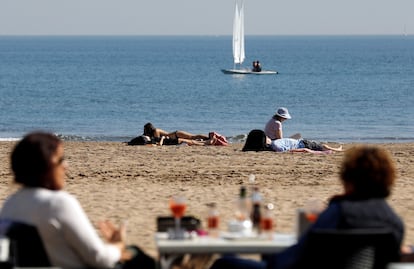Spain records hottest winter of this century
The average temperature in the country was 1.8 above the norm for the season, with some places seeing highs of more than 30ºC

This past winter in Spain was the hottest the country has seen this century. The average temperature was 1.8 degrees Celsius above the norm for the season (the reference being the average temperature between 1981 and 2010), according to a report by the Aemet state meteorological service, which looked at the results from weather stations between December 1 and February 29.
What’s more, the figures showed that this winter was the second-hottest since Aemet began keeping reliable records in 1965. The hottest winter in Spain was the season of 1989-1990.
Last winter, the Tenerife Sur airfield saw the thermometer rise to 31.9ºC
The report has confirmed that Spain is witnessing a trend that has been seen in many parts of the world: a rise in the number of record-breaking average temperatures. Experts attribute this phenomenon to climate change induced by human activity, which is causing a rise in greenhouse gas emissions.
The Ministry of Ecological Transition and Demographic Challenge, which oversees Aemet, reported on Wednesday that last December and January were the hottest on record at a global scale (equal to the records set in 2015 and 2016, respectively).
Europe also saw one of its hottest winters since records began, with the average temperature 3.4°C above the average between 1981 and 2010. Indeed, last February was the second-warmest the world has ever seen.
The problem, according to the experts, is not so much the record set last winter or in the past three months, but the fact that the record-breaking temperatures have become increasingly common during this century and decade.
As well as the rise in average temperatures, some areas of Spain saw record-high maximum temperatures, according to the Aemet report. The airport in Spain’s eastern city of Valencia, for instance, recorded a temperature of 29.6ºC, while the Tenerife Sur airfield, in the Canary Islands, saw the thermometer rise to 31.9ºC. Spain also saw unprecedented lows. The exclave city of Melilla in North Africa, for example, recorded a tropical night with a low of 20.4ºC in the middle of winter.
Saharan sandstorm
In its winter report, Aemet also mentioned the Saharan sandstorm that affected Spain’s Canary Islands between February 22 and 24. The weather agency explained that, in the absence of confirmation from historic records, this sandstorm was the hardest to hit the archipelago since instruments have been available to measure contaminants in the atmosphere.

“The episode consisted of three sandstorms that took place over three consecutive days,” the report explained. “What happened on February 23 was especially intense: there was a peak of above 3600 μg/m3 in PM10 [particulate matter with a diameter of 10 micrometers of less],” said the agency, which added this was 72 times the legal limit set to protect human health.
English version by Melissa Kitson.
Tu suscripción se está usando en otro dispositivo
¿Quieres añadir otro usuario a tu suscripción?
Si continúas leyendo en este dispositivo, no se podrá leer en el otro.
FlechaTu suscripción se está usando en otro dispositivo y solo puedes acceder a EL PAÍS desde un dispositivo a la vez.
Si quieres compartir tu cuenta, cambia tu suscripción a la modalidad Premium, así podrás añadir otro usuario. Cada uno accederá con su propia cuenta de email, lo que os permitirá personalizar vuestra experiencia en EL PAÍS.
¿Tienes una suscripción de empresa? Accede aquí para contratar más cuentas.
En el caso de no saber quién está usando tu cuenta, te recomendamos cambiar tu contraseña aquí.
Si decides continuar compartiendo tu cuenta, este mensaje se mostrará en tu dispositivo y en el de la otra persona que está usando tu cuenta de forma indefinida, afectando a tu experiencia de lectura. Puedes consultar aquí los términos y condiciones de la suscripción digital.
More information

Fires, sandstorms and blackouts: The ‘annus horribilis’ of Spain’s Canary Islands

Spain’s Canary Islands hit by Saharan sandstorm
Últimas noticias
Maduro pleads not guilty before the federal court in New York: ‘I am still the president of Venezuela’
A new test can detect Alzheimer’s from a finger prick
UN team enters Sudanese city of El Fasher after paramilitary massacre: ‘It’s like a ghost town’
A recipe for resistance: Indigenous peoples politicize their struggles from the kitchen
Most viewed
- Gilles Lipovetsky: ‘If you want to live better and fall in love, take Prozac, don’t look to philosophy’
- Alain Aspect, Nobel laureate in physics: ‘Einstein was so smart that he would have had to recognize quantum entanglement’
- Alvin Hellerstein, a 92-year-old judge appointed by Bill Clinton, to preside over Maduro’s trial in New York
- Why oil has been at the center of Venezuela-US conflicts for decades
- Cuba confirms death of 32 of its citizens in the US attack against Venezuela









































